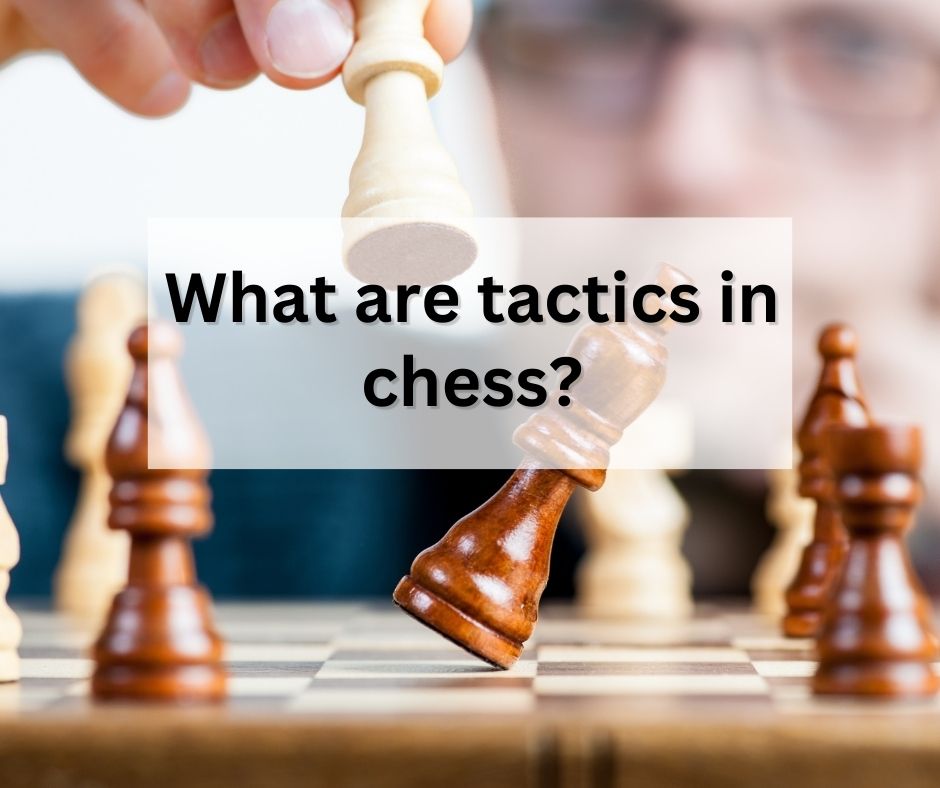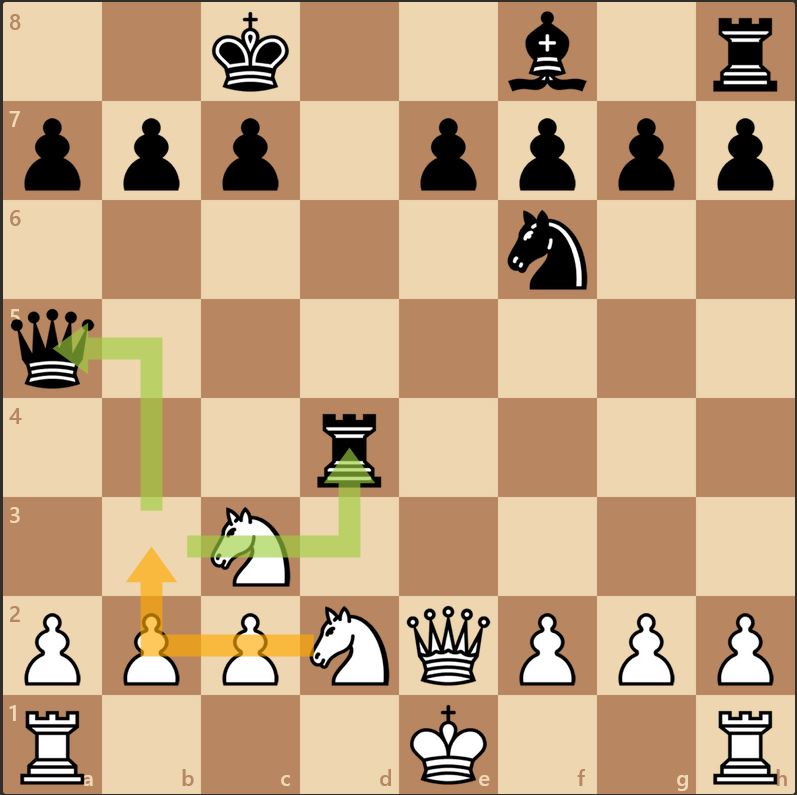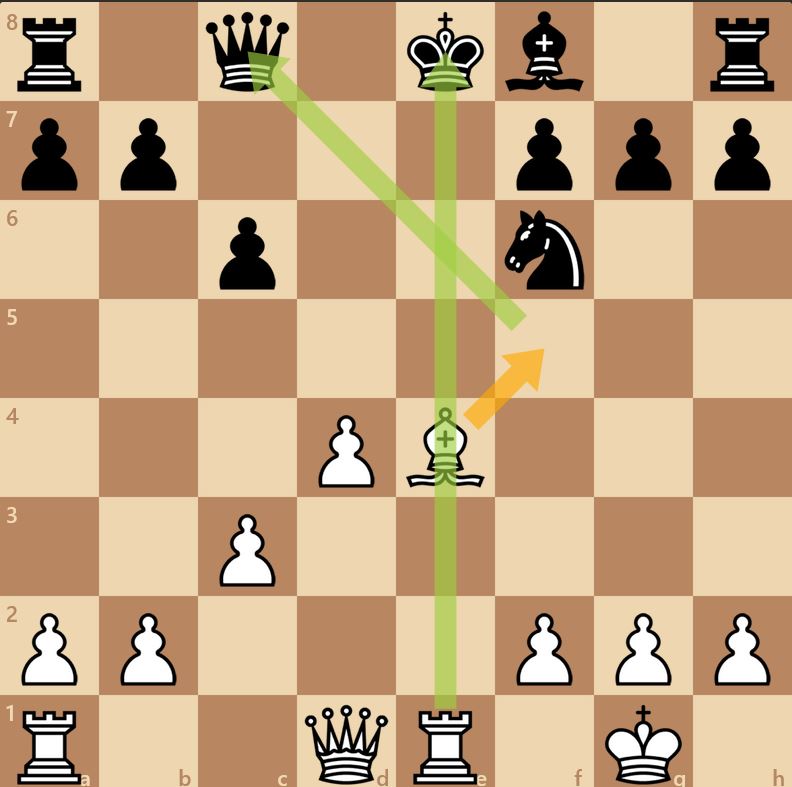Physical Address
304 North Cardinal St.
Dorchester Center, MA 02124
Physical Address
304 North Cardinal St.
Dorchester Center, MA 02124
Are you wondering, “What are tactics in chess?” If so, you’re in the right place.

Looking for a basic definition? Or do you want to sharpen your skills? Either way, I’ve got what you need.
First, we’ll explore what tactics are (and what they aren’t). Then we’ll discuss why they’re essential to your success on the board, and how you can start mastering them today. By the end, you’ll know what chess tactics are. Plus, you’ll learn practical steps to enhance your game.
Contents
Tactics in chess are short, concrete sequences of moves that force a specific outcome. These outcomes can include winning material, delivering checkmate, or achieving a positional advantage. Tactics involve patterns and themes that rely on precise calculation and quick thinking. In essence, tactics are about creating opportunities and exploiting your opponent’s mistakes.
Here’s a simple breakdown:
Recognizing these patterns is key to spotting tactics during a game.
In short, tactics are where clever calculations can turn the tide in your favor.
Imagine spotting a winning move in mere seconds, leaving your opponent scrambling. That’s the power of tactics. Keep reading, and you’ll learn how to study these game-changing patterns. Then start dominating the board like a master.
To understand chess tactics, let’s break it down. We’ll look at definition, characteristics, and real-world examples.
At their core, tactics are moves designed for immediate and concrete gains. They almost always begin with a check, capture, or threat. They result in either winning material, delivering checkmate, or gaining a positional advantage.
Unlike long-term strategies, tactics are all about precision and timing in the moment. Tactics often revolve around recurring themes or patterns, including:
Tactics:
Let’s consider a simple tactical example:
Imagine a position where your knight can move to a square that attacks both your opponent’s queen and a rook. This is a fork, as the knight threatens two high-value pieces at once. Your opponent can only save one piece.

Now, consider a more advanced example. You move your bishop, uncovering a rook’s direct line of attack on your opponent’s king. This move creates a check, allowing your bishop to attack and win another piece.

Tactics are short and straightforward. Combinations are more complex, multi-move sequences that often involve sacrifices and intermediate moves. They combine individual tactics that work together to achieve a major goal.
For example, a combination might begin with a queen sacrifice to lure the opponent’s king into the open. A series of forcing moves follows, culminating in checkmate.
Combinations showcase creativity and deeper calculation. They often earn praise as brilliant moments in chess history.
Learn to identify and execute both tactics and combinations. You’ll sharpen your ability to spot opportunities and create magic on the board. Next, let’s explore why mastering these skills is so critical for chess success.
Understanding what tactics are is important. But it’s also essential to understand what they are not. Let’s dispel common misconceptions about tactics.
Tactics and strategy are often confused. But they serve very different purposes in chess. Tactics are short-term, concrete sequences of moves aimed at achieving an immediate result. Strategy is all about long-term planning and positioning.
Think of strategy as the battle plan. It’s about controlling specific squares. It’s about maximizing piece mobility, and creating weaknesses in your opponent’s position. It’s about pawn structure.
By contrast, tactics are specific maneuvers or actions you take to execute your plan. For example:
A successful chess player meshes strategic foresight with tactical execution. Without a solid strategy, tactics may feel aimless. But without tactics, even the best strategic plans can crumble.
Many players, especially beginners, confuse tactics with “tricks” or “cheap shots.” This couldn’t be further from the truth. Tactics aren’t about catching your opponent off guard with gimmicks. They’re a natural part of the game, arising from the dynamics of a well-played position.
For instance, tactics often emerge when:
Tactics are not shortcuts. They are a testament to your ability to see the potential within a position. In fact, the best tactics come from strong strategic foundations. By playing sound chess, you’ll create tactical opportunities every game.
In summary, tactics are not separate from good chess—they’re integral to it. Now that we’ve clarified what tactics are not, let’s dive into why they’re so crucial to mastering the game.
What are tactics in chess good for? Well, they’re the beating heart of chess. They underpin the success of players at every level. This includes both complete beginners and world champions.
Mastering tactics isn’t about pulling off flashy moves. It’s about understanding the fundamental building blocks of the game. Here’s why tactics are so crucial to your chess journey:
Tactics play a decisive role in most chess games. At the beginner and amateur levels, tactical oversights decide most games. Novices miss opportunities to win material, or deliver checkmate. Worse, they often leave pieces undefended, and lose them.
Even at the highest levels, tactics are critical. Grandmasters spend years perfecting their ability to spot tactical opportunities. They use them to capitalize on the smallest positional advantages. And sometimes, a brilliant combination can salvage what was once a lost position.
If you want to skyrocket your results, there’s no better way than to focus on tactics.
Tactical training is like exercise for your brain. It sharpens your ability to calculate and visualize moves. By studying tactical patterns, you’ll develop the skill to look several moves ahead. Precise, efficient calculation is essential if you want to win chess games.
Tactical exercises force you to assess:
The more you practice, the more you’ll spot opportunities and avoid pitfalls in your games.
One of the most immediate benefits of mastering tactics is the confidence it brings. Recognizing familiar patterns—like a fork or a pin—will help you make faster, more accurate moves. This is valuable when you’re under time pressure and need to rely on your instincts.
Tactics come in many forms, each with its own unique purpose and execution. Here’s a comprehensive list of the most common types of tactics:
Thanks to computers and the internet, studying tactics is so much easier than it used to be. In my early chess days, we only had books with a few dozen or hundred tactics each.
Now we have access to loads of websites with thousands of tactical puzzles to solve. And the answers are immediate; no need to look in the back of the book.
My favorite site to study tactics is Chess.com because it “grows” with you. It tracks your progress and matches you with puzzles appropriate for your strength. Unfortunately, you do need a paid premium account to do unlimited puzzles. If that’s out of your budget, you can try a free site like chesstempo.
Solving tactical puzzles is usually enough to make serious progress. But you have to be consistent about it. Practice daily, or at least two or three times per week if you want to see results.
If you find yourself struggling despite frequent practice, you may need some lessons. If possible, figure out which tactical motifs are giving you the most trouble. Then look for video lessons aimed at that kind of tactic.
Seeing one or two examples is often enough to get you back on track. Again, Chess.com has some excellent lessons in both video and interactive formats. Another option is to search Youtube.
If you need more help with your calculation skills, I recommend this video by GM Igor Smirnov (affiliate link).
Studying tactics is essential for improving your chess game. A few common mistakes can hinder your progress, though. Avoiding these mistakes can make your tactical training more effective.
One of the biggest mistakes chess players make is focusing only on tactics. You also need strategic understanding. This is especially true once you reach intermediate levels.
Tactics and strategy are complementary. Tactics allow you to capitalize on opportunities. Strategy creates the positions where those opportunities arise.
Over-reliance on tactics can lead to:
To avoid this pitfall, balance your study of tactics with lessons in strategy. Learn about pawn structures, piece activity, and long-term planning.
It’s tempting to dive into complex puzzles and flashy combinations. Skipping foundational patterns can stunt your progress. Advanced tactics often build upon simple themes like forks, pins, and discovered attacks. Without a solid grasp of these basics, harder puzzles can can overwhelm you.
Signs of this pitfall include:
To prevent this, start with beginner-level puzzles. Focus on mastering one tactical theme at a time. Then increase the difficulty as your confidence grows.
Every game you play is an opportunity to learn, especially from missed tactics. Many players make the mistake of brushing past these moments. Take the time to understand why you failed to spot the opportunity.
By analyzing your games, you can:
Use tools like chess engines or online analysis boards to review your games. Focus on key positions where tactics played a role, and ask yourself questions like:
Avoiding these common pitfalls will make your tactical training more efficient and rewarding. Balance tactics with strategy. Master the basics before advancing. Analyze your games for missed opportunities. That way you’ll build a stronger, more complete understanding of chess tactics. Then watch your rating climb.
Now that you’ve gained a deeper understanding of chess tactics, it’s time to put that knowledge into action. Here’s how to integrate tactics into your chess training routine.
To master tactics, consistency is key. Dedicate time each day to solving puzzles. Review tactical patterns, and analyze your games for missed opportunities. Even 15–20 minutes of focused practice can lead to significant improvement over time.
While tactics are crucial, they’re only one part of the chess puzzle. To become a well-rounded player, balance your tactical practice with:
This holistic approach will make you a more versatile and dangerous opponent.
So, what are tactics in chess? They’re the first and most important step in your journey to chess mastery!
Improving at chess begins with action. The more you practice tactics, the more confident and skilled you’ll become. Don’t wait—grab a tactics book, fire up your favorite chess app, or dive into an online puzzle set. With dedication, you’ll soon find yourself capitalizing on opportunities like a pro.
Every great chess player started by mastering the basics, and you’re on the same journey. Take the next step today, and watch as your tactical prowess transforms your game!
And if you’re looking to accelerate your chess progress, click below to register for GM Igor Smirnov’s Free Masterclass, where he reveals how GMs think about the game.

[…] Tactics play a crucial role in chess. If you’ve opened well but miss a tactical shot during the middlegame, you could lose on the spot. Or you could win because your opponent does the same thing. For beginners, learning tactics is far more important than mastering lots of openings. […]
[…] In chess, tactics are short-term sequences of moves. They create an immediate advantage, often involving threats like captures, checks, or checkmate. Tactics rely on patterns such as pins, forks, skewers, and discovered attacks. They exploit an opponent’s weaknesses and gain material or a winning position. (For a more in depth definition with examples, see my post on What Are Tactics in Chess.) […]